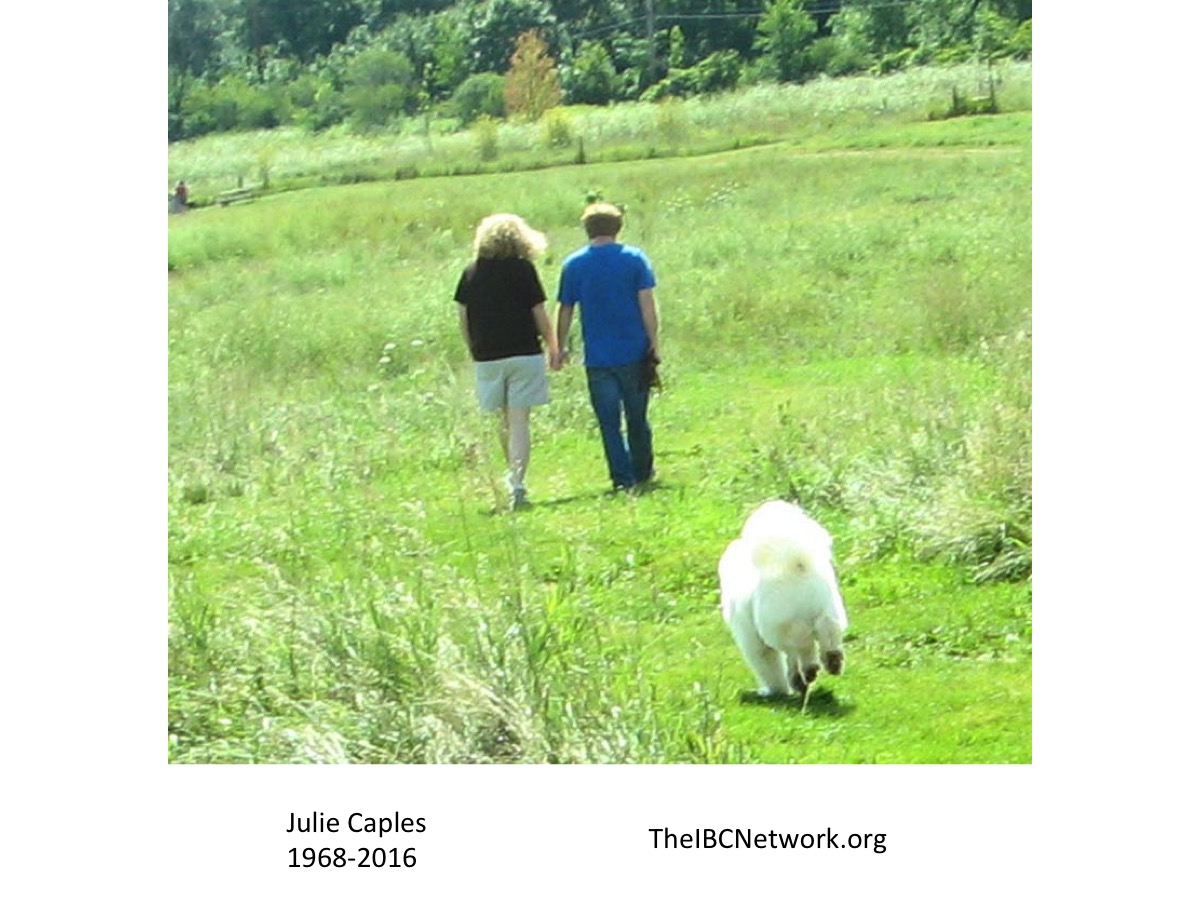
This story starts 17 years ago, in the last year of Williams Pinball's existence, though we didn't know it at the time. One day John Popadiuk grabbed me in the hallway and told me I had to immediately come look at something in the storage room across the hall from Steve Kordek's office.

There he pointed to a disheveled heap of full sized playfield drawings and told me that they were designs Harry Williams had done in the 1970s that had never been made. I sifted through the first few, and my impression was that Harry had clearly lost his mind. Here were 1950s playfield designs that he was drawing in the 1970s. But still, I was fascinated - all these games, designed by the master himself, that had never seen the light of day.

I could never really get the whole story out of Steve Kordek. Harry was sending in these designs to Steve, Steve was sitting on them, it really didn't make any sense.

But John was very excited about them. He decided then and there that when it came time to design the next game after Star Wars Episode I, we would start by having Jim and Jose in the whitewood lab build up one of these games so we could play it. Not because he really thought we'd end up producing a game anything like it, but because he thought the good pinball juju would flow from Harry's brain, through this game, into our brains, and we'd be inspired to create a true pinball masterpiece in the mold of Harry Williams.
Despite John's more recent misadventures, there is no denying that he is an absolute pinball zealot, through and through. His wonder and excitement at the thought of travelling back in time to learn at the feet of Harry Williams, via these playfield designs... it was contagious. We needed to finish up Star Wars and get it into production and show it off as the tournament game at Pinball Expo, and then we were going to hit the ground running on the next game as disciples of Harry. It gave me goosebumps!

...and then, as you know, on October 25, 1999 it all came crashing down.
There were tears to be wept, new jobs to be found, lives to be rearranged, and more important things to worry about than a stack of old playfield drawings. But I didn't forget them. As the years passed and I'd talk to Steve Kordek at various nostalgic get-togethers of ex-Williams employees, he'd discuss how all of his personal belongings - files, papers, games, books, everything from his nearly 40 years at Williams - had been moved up to the plant in Waukegan and he was trying to figure out how to get them out and back home. I own a pickup truck, I lived near the Waukegan plant, I have an undying devotion to the cause of pinball history, and I have a very understanding boss, Larry DeMar, so I offered absolutely unconditional help to Steve in this regard.
Any time, any amount of stuff, moved to any place he wanted. I always asked if those Harry Williams drawings were still in his stuff, and he always assured me they were.

I even bought a giant document scanner cheap on ebay and fixed it up, all in preparation for the day I got my hands on those drawings.

After a few years we managed to get some of Steve's games out of there - Pinball Circus, Ringer, Suspense, and so on.

After many, many more years, and some personal intervention by Ken Fedesna, we finally managed to get a large cache of his files out of there, but it was only about half of it. They said the rest was in "offsite storage" and, now that we had cleared out the first batch they would have room to bring the rest of it back inside to sort through, before letting Steve have it. Two things Steve and I verified that day: the Harry Williams drawings were absolutely still around, in the offsite storage; and "offsite storage" just meant a semi trailer sitting out in the parking lot. The folks at Williams said they were busy from then until the big Vegas trade show in the fall, but we could check back later in the year to coordinate coming back for the second half of Steve's stuff.
"Later that year" turned into more and more years. No amount of pestering could get any further action out of Williams. Steve couldn't get them to return his calls, they certainly weren't returning my calls. Only one person had control of the storage portions of the factory, but they also required people from Legal to bless anything leaving the building, so it required some coordination and it was nobody's priority.
As Steve got older and realized he needed to make plans for all of his vast belongings (OK, I'll say it, his hoardings! Steve was a hoarder, plain and simple. And pinball history is so much the richer for it!), he decided that Larry and I would be worthy keepers of the historical flame.

That first batch of files from Waukegan came back to our offices and filled our common area like a bad episode of Storage Wars. As I slowly sorted through it and organized it, Steve would come by and visit and chat and offer guidance about what it all was.

As he neared the age of 100 and his health was wavering even more, he made it clear to his family that upon his death a lot of his files from his basement at home would come to join the rest of his archives at our office... and when that dreaded day came to pass, they did.
But his death also marked another sad milestone: we had never retrieved the rest of his files from Waukegan, and now he was gone. I was never going to see those Harry Williams drawings again. Someday someone at the plant would be cleaning up old junk, not recognize these drawings for what they were, and off they would head to the landfill.

I just couldn't bear the thought! I pulled out all the stops. I got the email address of a lawyer at Williams who I was told could slice through all the red tape and make this happen. I wrote him an impassioned plea, describing the situation and begging for help for me, for Steve's family, for pinball historians everywhere, to get the last of his archives back together after all these years. A few days later I got an email from a Williams paralegal basically saying "sorry, there is no more stuff of Steve Kordek's here." I was crushed. That was it. The Lost Playfield Drawings Of Harry Williams were now truly lost.

Over the next couple of years, my pinball history itch was scratched quite nicely by sorting through the portions of Steve's archives that we had succeeded in rescuing. Triageing, organizing, filing, scanning, uploading to IPDB. It was a lot of distracting work, but the thought of Harry's drawings was never far from my mind.

Especially when, in a mouse-nest-infested tube of rolled up drawings from Steve's garage, I found blueprint copies of a couple of them! Hey, at least I had proof in my hands that I didn't just dream up the whole thing.
But in this same time, that one person who had control of the storage areas in Waukegan, the very last person with any memory of Steve's stuff, retired. And Williams merged with another company. And then they merged again, with Bally Gaming. And then they moved manufacturing to Las Vegas and moved out of the plant in Waukegan. If I had even the tiniest sliver of hope for these drawings it was now gone.

Then one day in June of 2015 I got a call from Gary Flower. He's always calling with some interesting question or a tidbit of pinball information, but today his question about made me weep. Try to imagine this in a British accent:
"Duncan, I remember one time back when Williams was still in the pinball business, I visited Steve Kordek, and he led me into a room and opened a cabinet and showed me a bunch of playfield designs that he said were done by Harry Williams in the 1970s but never got made. Do you know anything about those, or where they might have ended up?"
AIEEEEEEE!!!!! Sore subject, Gary!! I gave him the very condensed version of this story and told him it was too late, Williams had left the building (literally!) and if those things had still been there, they were now gone. He told me that the people were gone, but Williams was still organizing and moving the contents of the building and preparing for an auction later, so maybe now was the time to try to find them at last. I pointed out that pretty much anyone with any care for pinball was gone from any position of power there, and how could we possibly get in to look around?
He asked if I knew Tim Seckel and I said I did not. He said Tim was VP of Engineering at Williams now, and had designed pins for Data East, and was a die hard pinball fan and maybe he could help. So he put me in touch with Tim, and I gave Tim the even more condensed version of the story. He said he would personally drive up to Waukegan and look around for these drawings.
A few days later he called me back to say that he had no luck finding them. There were just the old production playfield drawings from the 40s through 70s in their normal storage cabinets.

Whoa - I couldn't let that little morsel go by without comment! I told him purely as a person greatly invested in the history of pinball I wanted to know what was going to become of those drawings. I would certainly hate to see them chucked as useless old pieces of paper! He totally understood and said he'd call me back. Next time I heard from him he also had a Williams lawyer on the line and basically said "OK, we're listening, what do you propose happens to those drawings?" Talk about being put on the spot. Clearly they were never going to go for an answer of "hey, just give them to meeeeeee!!"
The first thing I could think of was The Strong Museum of Play up in Rochester. An honest to goodness real museum that they could donate them to, that would be happy to get them, and where they could join other priceless artifacts of coin-op history like the Atari engineering archives. Tim and the lawyer liked that idea! But there was a hitch. They didn't just want to give up the drawings without getting copies of them, but all of their document copying equipment had already been shipped to Vegas, and there was certainly no money in anyone's budget to send these to Kinko's for copies to be made. I said "I have a crazy idea - I own a document scanner big enough to handle these. Let me have these drawings briefly so that I can scan them and send you copies or files, then I will pass them along to the folks in Rochester." And lo and behold they went for it!
I had to sign some legal documents but then they set it up.

And then right in the middle of all this my wife Julie was diagnosed with a very rare and very aggressive form of breast cancer, and we were spending a lot of time at hospitals getting tests but she's a big pinball fan too and bless her heart she encouraged me to get this done while working around her schedule. So there I am one holiday morning before July 4th, at an eerily vacant Williams plant in Waukegan, explaining to the security guard that I'm trying to pick up some boxes or cabinets full of paper. He finally finds someone who knows something about it and directs me to park at a loading dock at the far end of the plant.

While I'm sitting there waiting for the door to open, I see a lone semi trailer just sitting in the lot! Is this the infamous "offsite storage?" I actually emailed a picture of it to Tim Seckel asking him if anyone had checked in there (he later responded that the plant security folks assured him it was completely empty.)

So they loaded up my truck with two metal cabinets and a giant cardboard box just crammed full with rolled up and crushed vellum prints and off I drive to my office to unload it all into the poor beleagured common area, site of so much pinball history de-hoarding. I told my wife I'd be right back home so there was no time for anything but dump and run, but I can't resist just peeking in the cabinets to see what I'm facing in terms of scanning.

Aw crap, some of the prints have fallen from their hangers and are getting all crumpled and kinked in the bottom of the cabinet. I pull them out to lay them out flat...and then I look at them a little more closely... and then shivers go up my spine and I feel a little faint. I won't relay to you the long string of joyful expletives that I actually said out loud in this empty office, I'll just tell you that I was staring at some of The. Lost. Playfield. Drawings. Of. Harry. Williams. I checked the cabinet and there they all were - over 60 of them, hanging merrily alongside the early production playfield drawings that were all I had expected to find. It was painful, knowing I wouldn't be back here for days until after the holiday weekend, but I had to go home...though with a huge grin on my face. Steve had hidden those suckers in plain sight.
I called Tim Seckel later that day and let him know, so he'd stop searching the nooks and crannies of the plant to find them. I called Gary Flower and let him know that his offhand, out of the blue, later-than-11th-hour question, along with my oh-by-the-way question about the fate of the production playfield drawings, had actually led to a successful end to my 16 year quest.

And still the Harry Williams drawings had to stay tantalizingly just out of reach for a while longer. I had made a deal to scan all the production drawings for Williams then ship the originals to Rochester, and that promise took precedence.

A month later I wrapped that up, but at an extreme amount of damage to the expensive wear parts of my scanner, due to how old and damaged the Williams drawings were.

So still Harry's legacy had to wait while I resurrected a parts scanner I'd picked up from ebay along the way. After all, I wanted these scans to be flawless!

But finally I got it done. 60-odd scans of these giant, detailed, full-sized, fully-dimensioned playfield designs. They were frankly unmanageable at full size. I couldn't even get my head around them at that scale, with so many of them.

But once they were scanned, I printed them all on 11x17 paper and put them in a binder, and I could finally take stock of what I had. And what I found was GENIUS. My first impression of these had been all wrong, I was misinformed by only looking at a couple of designs and not fully understanding what they were showing.
But now what? A 16 year quest, the first 13 of which had been spent with Steve Kordek by my side, the last 3 on my own, and now that I had finally done it... now what? And I don't think there's really any question that these games needed to be built. 40-odd years after Harry put pencil to mylar, some of these games needed to finally be built and played.
Harry Williams once described the appeal of pinball as: "The Ball Is Wild!" And in these designs he tried to ensure that was true, in some cases in ways that had never been seen before, and have never been seen since. Harry loved gimmicks and gadgets and was always dreaming up new and unique mechanisms for coin-op games, and these designs are no different. On many of these drawings the game description includes the phrase "see supplementary drawing" for details on a unique mechanism. Sadly, those supplementary drawings all seem to have been lost to time. But it's possible in context to figure out how most of them must have worked and how they'd need to be constructed.
There is a series of a dozen or so games that have some sort of weird scoring magnet thingy that had me a bit stumped until I realized Harry had used that exact mechanism on his 8th game from Williams, 1947's Torchy.

So I can just use a Torchy mechanism as a guide for where to start, in building the slightly different magnet mechanism in these games.
While all of these thoughts are going through my head, there's still the nagging question of "Why? Why are these interesting games sitting here on pieces of paper, and not in the history books as successful Williams pinball machines?" Steve had never given me a straight answer and he was no longer around to pester for more details. Norm Clark was the other Williams designer at the time but he too has passed on.

I thought of trying to see if some of the draftsmen or protype shop names I had seen on all of those production playfield drawings belonged to people who were still alive, but the odds of any of them knowing anything about this seemed very slim.

But then I stumbled upon the fact that Jack Mittel was still alive and living in the area! He had been head of marketing at Williams from the early 60s all the way through the dawn of the solid state era. Maybe he would know! It took a while to finally arrange a time to talk on the phone, because he was in his 80s and he had a lot of regular medical appointments.

Finally Steve Ritchie and I paid him a visit at his home one weekend, because Steve considers him his mentor from when Steve started at Williams in the late 70s.
Jack was not specifically familiar with this cache of unmade games, I guess because Steve had squirreled them away all these years, but he did outline for me the circumstances that would have led to this situation. According to Jack, Harry had a couple of ex-wives plus a penchant for dating "fast women" (those are Jack's words, not mine!) which was apparently an expensive hobby. So he would have always been looking for sources of additional income, and with his love of pinball and his design talents, what better thing to do than pitch game designs to his friends at his former company? But here's the thing, it's not enough to just have a game design, you also need someone to shepherd it through the whole process, get resources allocated for it, make sure all those millions of other things get done, that are required between the time you have an idea on paper, and games are shipping out the loading dock. In my time at Williams I heard this referred to as "the Game Dad for a game" a term coined by Larry DeMar. It doesn't always have to be the designer, though it often is. It has to be the person most interested in getting that game made. For instance on Junkyard, Dwight Sullivan was the Game Dad, even though Barry Oursler did the majority of the playfield design. So you can see the problem here. Steve Kordek and Norm Clark have their own designs they want Williams to make. They're not going to volunteer to be Game Dad on someone else's design, even someone they know and like.
So there's the brutal truth - these games didn't get made because making them would have meant Steve or Norm giving up a production slot for one of their own games. I guess that's why Steve was hesitant to discuss this, because unless you really understand the whole situation, it sounds kind of selfish. But I get it. And kudos to Steve, he hung on to these drawings for decades, he didn't just feed them into a shredder.

A sad postscript here, Jack Mittel passed away a few months after we met with him, in April of this year.
Now here's another little fun fact I discovered, once I had both Harry's drawings and the Williams production drawings in my hand at the same time, however briefly: two of the games in this series did actually get made! Sort of.

Harry designed a 4-player game called "Valencia" that later got reworked a little by Gordon Horlick into a 2-player game called Toledo.

They actually made 65 Valencia sample games, but it never went into full production. However they made 3001 copies of Toledo and it was a pretty successful game!


There was another game, a 2-player design called "Tramway" that was reworked a little bit, again by Gordon Horlick, and they went as far as to make 1 or 2 fully complete games with artwork, and scheduled it for production, but production never happened in the end.

I asked Jack about that and while he didn't remember Tramway specifically he said that that if a game didn't do well at test locations, it didn't get made, period. He was in charge of that sort of decision, and it came down to whether he thought a game would even be able to recoup its production cost if sold at a deep discount in a worst case scenario, and if the earnings were not there, production was not authorized. So there's a vote of no-confidence in these playfield designs by Harry, but maybe they just picked the wrong one, or maybe Gordon's tweaks weren't the right ones, or something.
So who was this Gordon Horlick? That's actually a subject James Loflin and I will touch upon in our seminar tomorrow, but I'll give you the short version: he was Harry's and Sam Stern's longtime employee and engineering buddy, going all the way back to the earliest days of Williams in the 1940s.

By the 1970s he was in charge of engineering at Williams, and though Jack kept insisting to me that "Gordon was no game designer!" he did have a hand in a lot of the really early Williams game designs...and clearly he was willing to step up and be Game Dad for Toledo and Tramway, despite not officially being in that role normally.
Once I decided to bring one of these designs to life, then the question became - how do I possibly choose which one? First I whittled it down by rejecting all of the ones with the scoring magnet thingy, because that was going to be too much mechanical engineering to complete in time for Pinball Expo.

Then I removed from consideration all of them with unusual bottom end flipper arrangements. Those games are almost always failures, and I didn't want to take such a big risk for the first one. Similarly I ruled out ones that required overly complicated mechanisms or rules, including a few with multiball (as Williams had no multiball system in the 70s EM era which I could use to start building a game.)
Then I tossed out a few that just didn't look fun or interesting enough. That got it down to 14. I took a harder look at the time I had remaining to build the game, and the complexity of the hardware or rules, and got it down to just 9. Then I had my wife help me just choose one out of those, and she picked Typhoon.
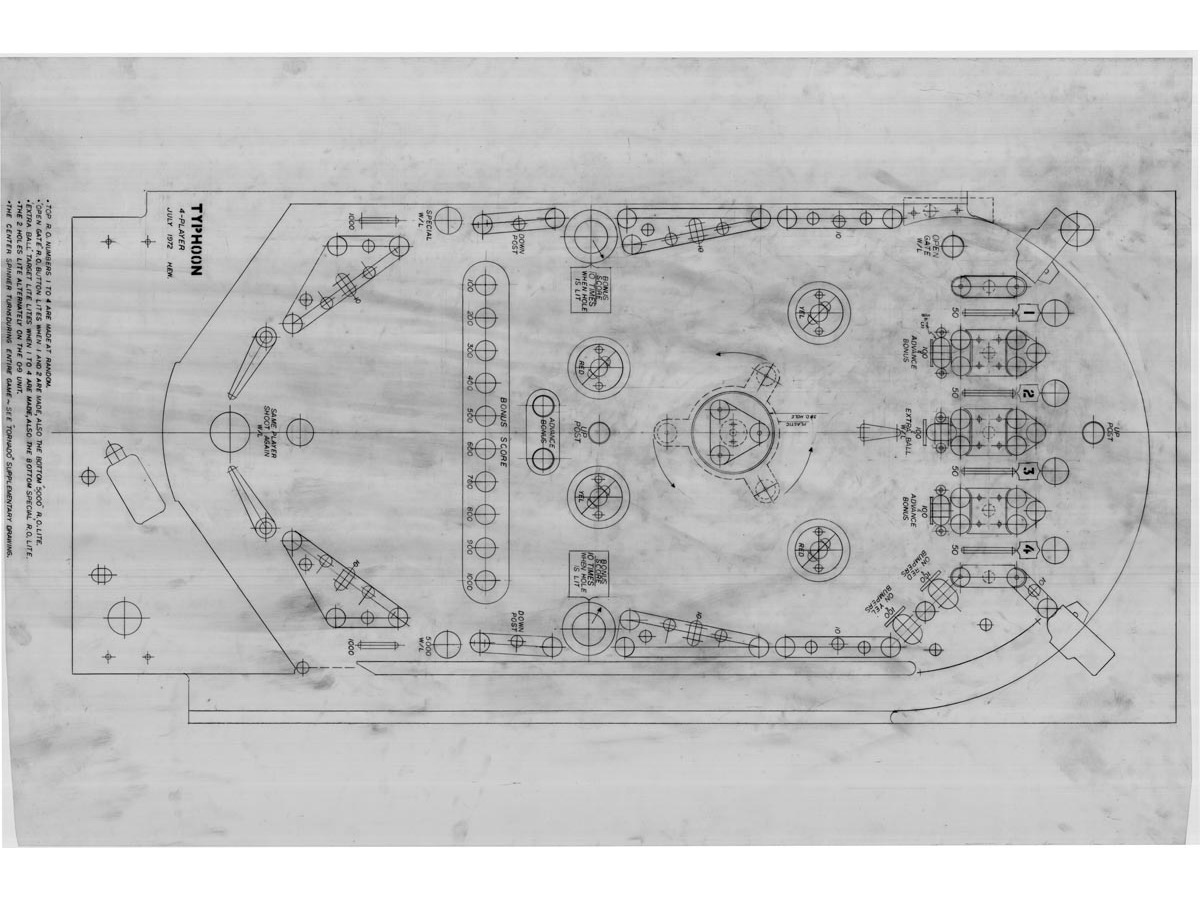
So Typhoon it is! It was only after we'd decided on Typhoon when I finally noticed that, in addition to the whirling mechanism and the pop bumpers, it also had upper slingshots - the ball was truly going to be wild!

Another extremely sad postscript here, my wife passed away a couple of months after this, in July of this year. It's been a very tough year. But she was as excited as I was at the prospect of bringing one of these 1970s time capsules to life, so I press on. I sure do miss that girl. I love you, Julie, and this seminar is dedicated to you.
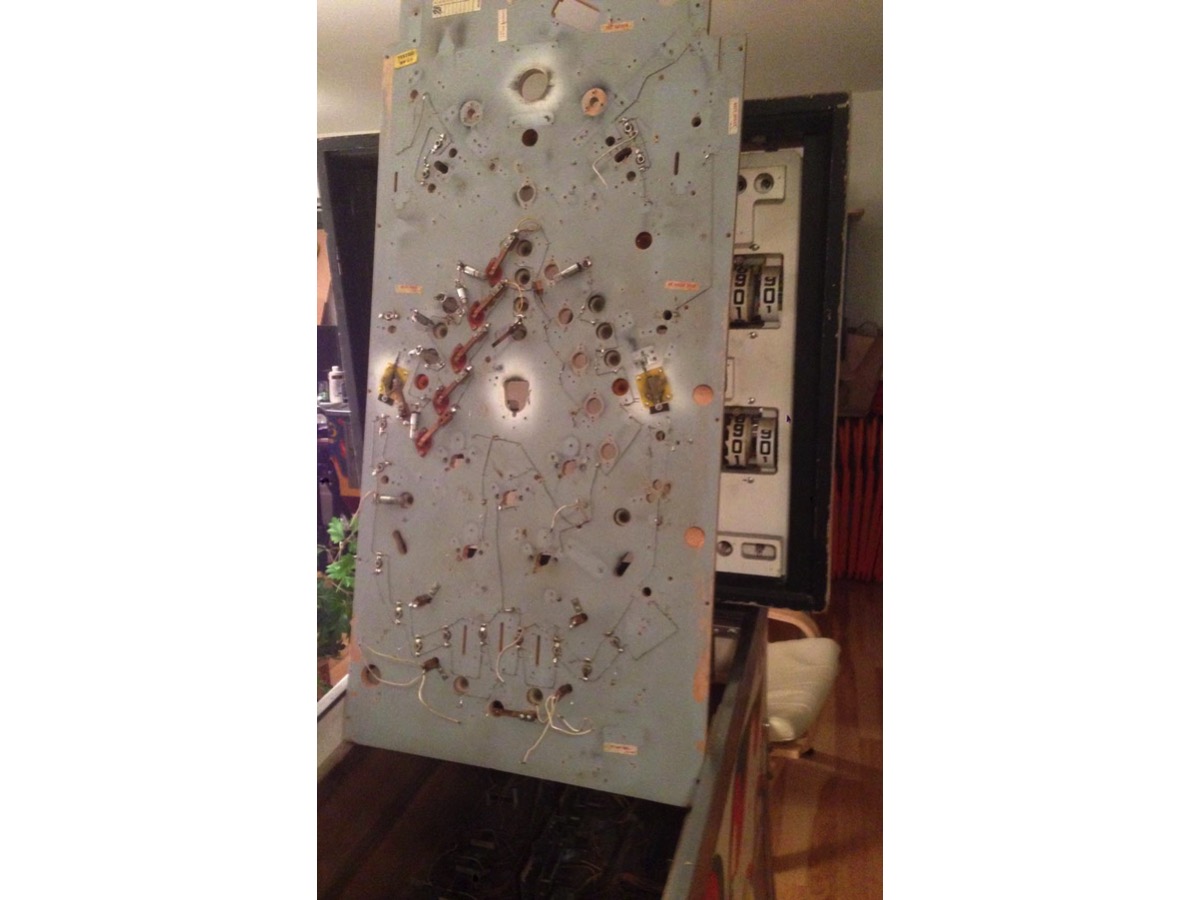
I knew by starting with an existing Williams parts game from the era that I could bring up a flipping whitewood pretty quickly - all the right voltages are there, the player-up, ball-in-play, and basic scoring circuitry are all there, and so on.

So I decided I was going to give this game the exact treatment it should have gotten in the Williams prototype lab 40 years ago... including "programming the software" using relays and steppers - no cheating with a P-Roc or something here, no sirree. This design may have been asleep for 40 years but it was time to wake it up from its suspended animation just like it was still July of 1972.
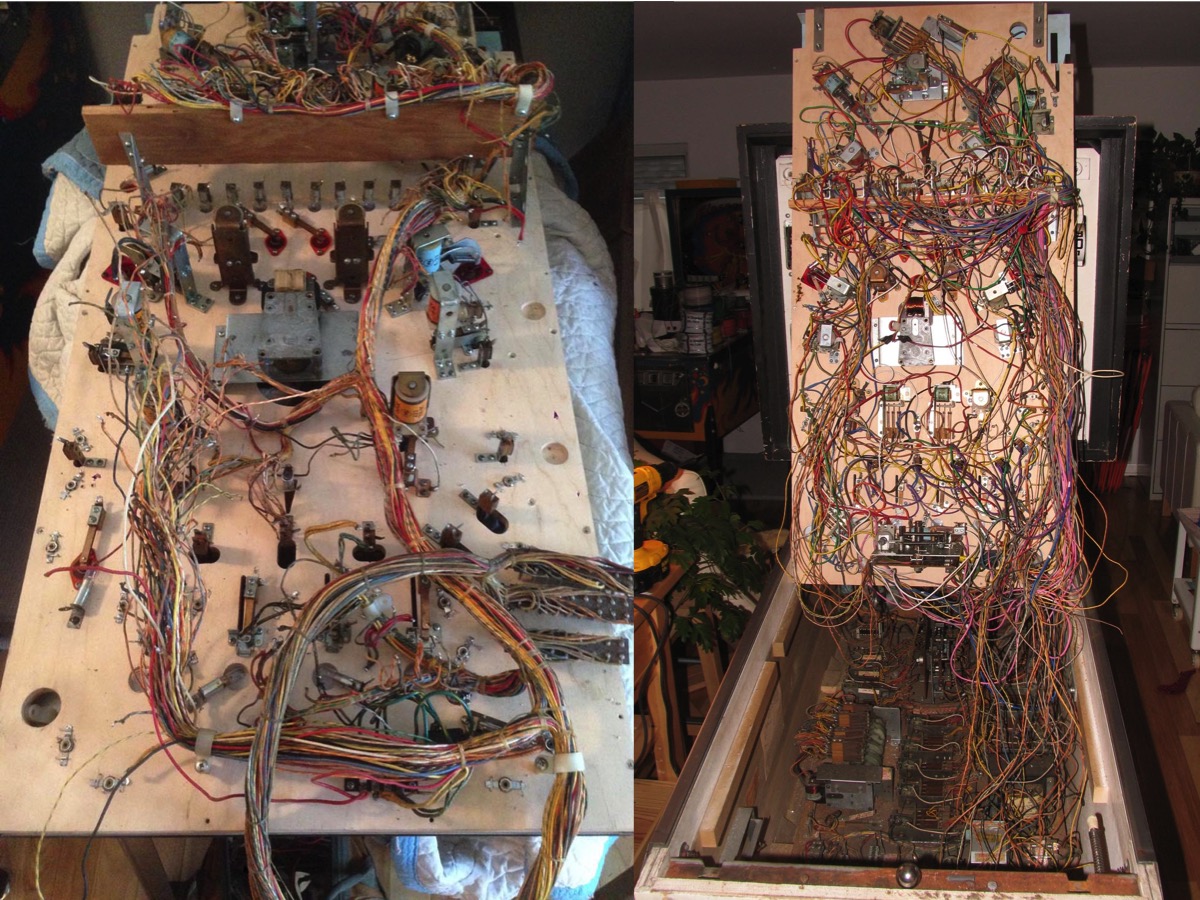
And that game is here at Expo now, for you to play.
Remember, this is the first whitewood - if this really was July of 1972, Gordon and Harry and Steve and Norm and Sam would all play the game and perhaps find flaws and tweak things. But I'm not worthy of second-guessing Harry's initial design, so I built it precisely like he drew it, and we can all play it and decide how good a job he did. And maybe some of that pinball juju will flow from Harry's brain, through his drawings, into the whitewood, and then on into your brains. If you see me around the show, let me know what you think of it, or post a thread to rgp and let the people who couldn't make it to this year's Expo know what they're missing!
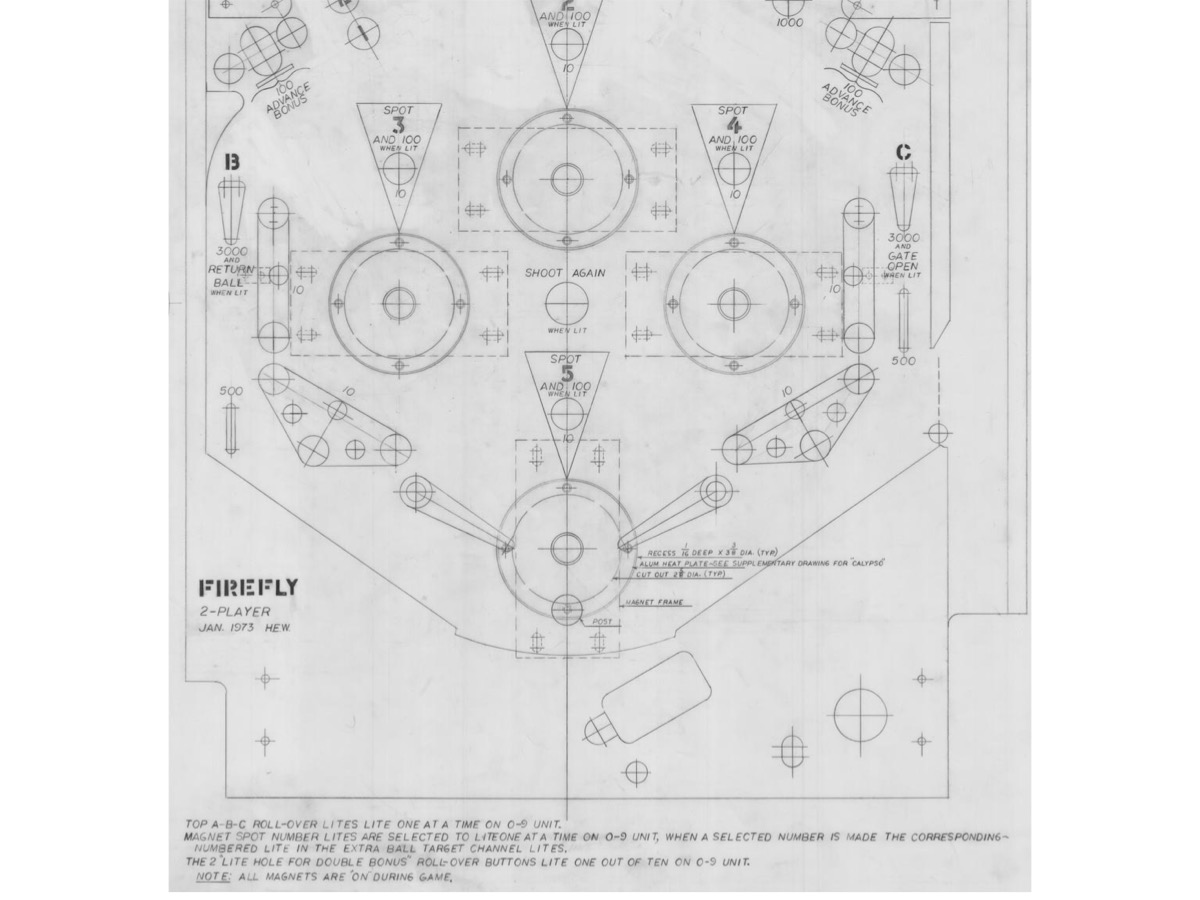
It is my plan to build up more of these games. I might just try one of those scoring magnet thingy games next - some of them have 5 magnets! Check back again at next year's Expo and see what I've come up with.
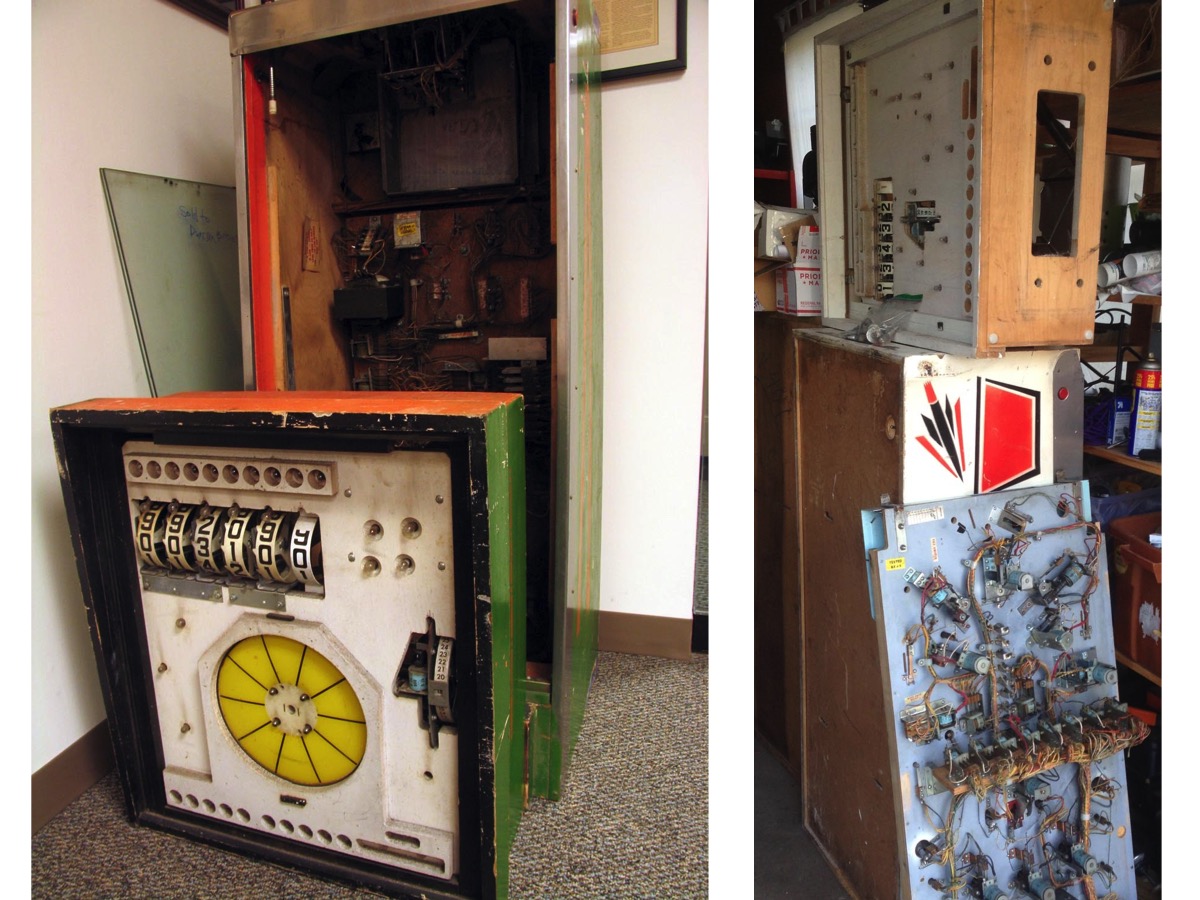
I'll end with two personal plugs - if you have any trashed-out, unrepairable Williams EM parts games from the 1970s that you're willing to sell me cheaply, I'd like to pick up a couple of more to use for building up these games. And if you'd like to do something to help put an end to the scourge that is Inflammatory Breast Cancer, please consider giving a donation in the memory of Julie Caples to TheIBCNetwork.com
Thanks.
